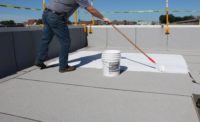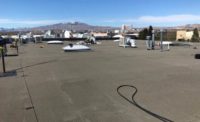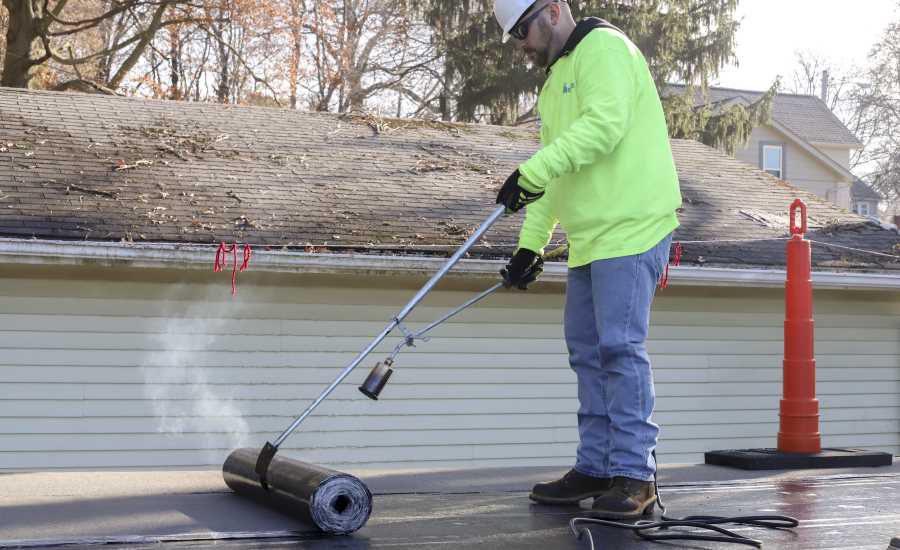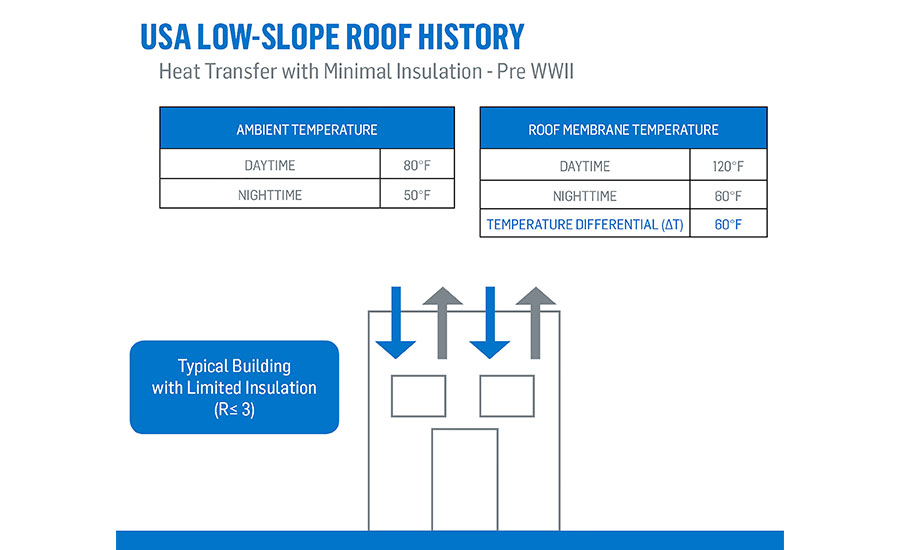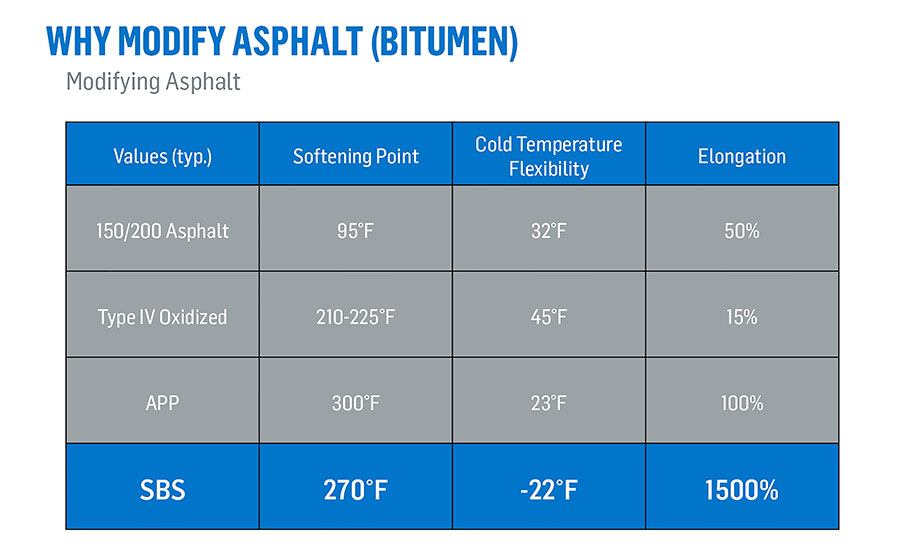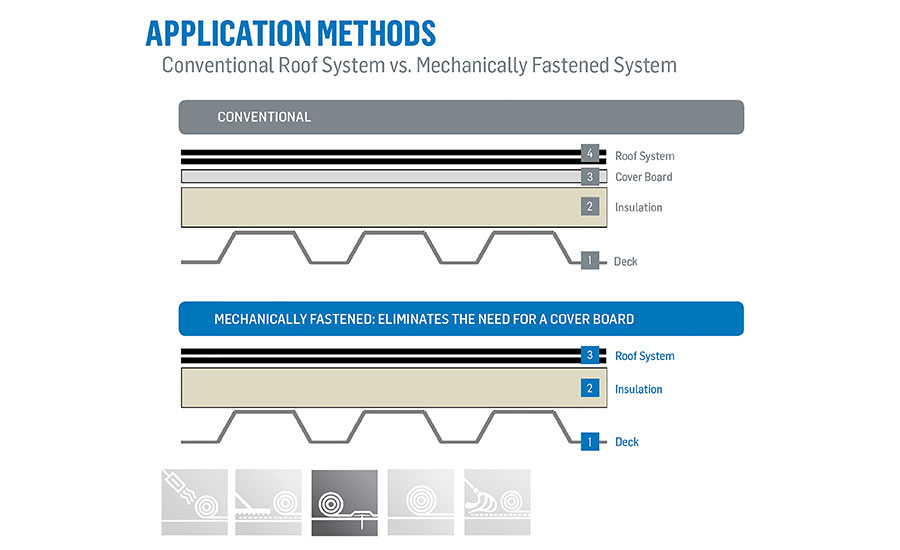CEU: SBS-Modified Bitumen Roofing
A look at product composition, properties and code-related attributes


What do all four of these items have in common? They provide safety and protection through redundancy, much like a multi-ply roofing system.


U.S. low-slope roof history. Heat transfer with minimal insulation—Pre-WWII. When there is minimal insulation installed near the roofing surface, heat transfers more smoothly to the structure, reducing the heat load on the roofing membrane.

Heat transfer with significant insulation—Post-WWII. The addition of more insulation near the roof means that heat cannot transmit as well to the structure, and therefore the temperature differential experienced by the roofing membrane is much higher.

Asphalt is the key ingredient. When crude oil is refined and distilled, there are a large number of byproducts that result. The one we are most interested in from a roofing perspective is asphalt flux.

Here you can see the properties of various types of asphalt, both modified and unmodified, to give you a better understanding of how they perform in roofing applications.

This chart shows the properties of various reinforcement materials. The right choice will depend largely on the needs of your application.

This graph shows a conventional roof system versus a mechanically fastened system. You will notice that with the mechanically fastened system, cover board is not required.

















After reading this article, you should be able to:
- Describe the history and development of SBS-modified bitumen roofing systems, including their anatomy, material properties and building code considerations, such as fire- and wind-resistance.
- Explain modified bitumen sheet anatomy, incorporating discussion of heat-weldable, self-adhesive and cold-adhesive-applied sheets.
- Discuss roof system applications, including pertinence to environmental and safety impact.
- Describe modified bitumen membrane surfacing, including highly reflective surfacing material options and their impact on building performance.
1 AIA LU/HSW; 1 IIBEC CEU; 0.1 IACET CEU
An Introduction to Roofing Technologies
We sometimes hear people state that they are thankful simply to have a “roof over their head,” and with good reason. Roofs serve the fundamental job of protecting us from the elements, and they are often taken for granted until a leak or other structural deficiency manifests. As building professionals, it is our job to understand not only how to construct and repair roofs, but to know enough about the roofing membrane material and application methods available to us to ensure we are installing long-term protective solutions that will last in a given environment.
While there are a number of roofing membrane technologies available on the market today, not all are created equal, nor are they created to necessarily excel in the same applications. If we attempt to categorize the membrane systems available, the simplest way to do so would be to bucket them into “single-ply” and “multi-ply” technologies. Single-ply roofing typically consists of a synthetic sheet material that is factory-manufactured and is most often comprised of polyvinyl chloride (PVC), thermoplastic polyolefin (TPO) or ethylene propylene diene monomer (EPDM) polymer formulations. Multi-ply, or “built-up” roofing systems are comprised of various protective layers, and generally rely on some form of asphalt to provide waterproofing performance. This content will focus primarily on multi-ply roofing systems, and will examine the nuances of styrene-butadiene-styrene (SBS)-modified bitumen systems in particular.
The following topics will be covered:
- Advantages of multi-ply roof membrane constructions.
- The history of SBS-modified bitumen membrane usage.
- SBS-modified bitumen membrane composition.
- SBS-modified bitumen application methods.
- Recent developments in SBS-modified bitumen materials.
Advantages of Multi-Ply Roofing
Let’s start with a fairly basic question: why would we choose multi-ply roof membranes over single-ply options? The answer: they all provide protection through redundancy. Redundancy is the duplication of critical components or functions with the intention of increasing reliability of the system, usually in the form of a backup or fail-safe mechanism. Bullet-proof vests have multiple layers of Kevlar, hospitals have backup generators and equipment, tires have multiple plies to prevent punctures, and the space shuttle has hundreds of examples of redundancy from heat panels to the internal systems. These items are integral to the protection of people and equipment, and they’re more effective because of redundancy.
The chief responsibility of a roofing membrane system is to protect the building and everything in it from water intrusion. As is the case in the examples above, redundancy keeps the people and valuable items inside a building dry. A single-ply roofing system is not always adequate to withstand all the elements and conditions that are sure to attack the roof membrane, whereas a multi-ply system is better equipped to handle all conditions. Unlike relatively “disposable” mobile phones and computers, roof membranes must endure all that man and Mother Nature can dish out, and they must perform for decades, not merely a few years.
This article will chiefly cover SBS-modified bitumen and multi-ply roofing systems. SBS-modified bitumen refers to the specific composition of the roofing membrane. These membrane materials are often combined with additional layers of SBS-modified bitumen, PMMA liquid-applied membrane, PVC synthetic single-ply membrane or other materials to provide buildings with layers of robust protection against the elements. Before we get into the technical aspects of these systems, it’s important to understand the basic history of modern roofing systems to fully grasp what materials we have at our disposal today, and how that came to be the case.
Roofing Materials, Market and History
Today’s Low-slope Roofing Market
In the U.S., about two-thirds of the market is made up of single-ply membranes comprised of materials such as TPO, EPDM, PVC, plus a few others. Why is this the case, if we started out by saying that multi-ply roofing systems offer better protection? There are a few reasons. The growth in single-ply membranes over the years has been primarily price-driven. Also, single-ply membranes have fewer barriers to entry for contractors because there is less equipment required than other systems and it’s thought to be easier to install.
Recent findings show demand for plastic roofing has risen sharply over the past decade, spurred by rising consumer interest in self-adhesive TPO membranes that reduce the time and cost of roof installation jobs. Also, plastic roofing technology is expected to advance most rapidly, supported by continuing consumer interest because of its favorable performance properties and ease of installation. Additionally, rising interest in improving energy efficiency will encourage building owners and managers to install cool roofing materials, such as white- or light-colored TPO or PVC membranes, that deflect sunlight and minimize the heat transfer from the roof to a building’s interior.
Commercial reroofing in the United States spiked in 2016 following a season of severe storm activity. Low-slope roofs that were damaged by hail, prolonged exposure to moisture, heavy snowfall, and freeze/thaw cracking had to be repaired or replaced. Through 2021, reroofing will account for the majority of low-slope roofing demand in the U.S. as many structures feature roofs at or near the end of their expected product lifespans.
Reportedly, growth of the low-slope roofing market will be supported by the expected increase in commercial building construction spending. Rising construction of office complexes, retail sites and lodging facilities will boost low-slope roofing demand, as many of these buildings have large roof expanses. The institutional segment will also promote demand for low-slope roofing, as the nation’s aging population will encourage builders to construct hospitals, medical facilities and senior living complexes to meet the needs of this expanding population segment.
According to the 2014–2015 NRCA Market Survey, SBS-modified bitumen made up approximately 23 percent of the low slope roofing market in the U.S., and the “other” materials made up the last 11 percent of the market include foam and metal. Outside the U.S., however, multi-ply systems are far more common.
- In Canada, low-slope roofs are primarily covered with SBS-modified bitumen membranes. Part of the reason is SBS-modified bitumen systems’ ability to stand up to the continental climate of Canada that leads to winter temperatures between 5 and -40 degrees Fahrenheit (-20 and -40 degrees Celsius).
- In much of Europe, the market is also dominated by SBS-modified bitumen. Modified bitumen membranes originated in Europe in the late 1960s, with many countries developing their own formulations and applications, leading to a strong modified bitumen market built on a track record of proven success.
Historical Overview
Bitumen has been used for centuries in its natural form to waterproof everything from boats to bathtubs to buildings. After the distillation of crude oil began, oxidized asphalt entered the market in the 1890s and became a substitute for the highly odiferous coal tar pitch that was used for built-up roofing (BUR) applications.
Felts made up of rag, paper or asbestos were saturated with asphalt and used in early BUR systems. For various reasons, including performance and availability of some raw materials, BUR felts evolved to a higher performing fiberglass composition in the 1970s. A typical BUR roof consists of 3-5 plies of these felts and some form of UV protection—usually gravel or a coating.
One thing to remember about BUR roofing membranes is that they are constructed “in-situ,” i.e., the membrane is “manufactured” by the installer on the rooftop. Individual BUR ply sheets are not watertight, but when applied with hot asphalt in multiple layers they serve to reinforce the waterproofing agent—the bitumen (asphalt). Besides its composition, the quality of the installed waterproofing agent is dependent on many factors including the skill and workmanship of the installer, the kettle temperature, the length of time in the kettle and conditions during application.
In the early 1900s, about 90 percent of the U.S. low-slope roofing market was of the BUR variety. As of 2015, only 9 percent of the market was BUR. So, you may be wondering, what happened?
To understand, all we need to do is look at pre-World War II and post-World War II market conditions.
Pre-WWII, the roof slopes were steeper than today, many times 1-3 inches-per-foot, and the rooftops were not encumbered with mechanical equipment. Air conditioning was not common, there were no satellite dishes or cell towers, and there were few roof vents. Rooftops were generally simpler. Roof decks were made of wood or concrete, meaning there was very little movement in the roof deck and the structure. Asphalt and felts and quality bitumen were prevalent. Finally, there was a large labor force that was accustomed to manual labor and in need of well-paying jobs.
After WWII, a lot changed. Buildings’ roofs were often built with slopes of less than 1-inch-per-foot. Lightweight steel decks were used, which made for more expansion and contraction and therefore more deck movement, but less mass than wood or concrete to absorb heat as a heat sink. There was also an increase in the use of rooftop insulation in the mid-1900s, meaning that more of that heat energy would not be transferred, and would rather attack the roof surface. In addition, HVAC and other equipment moved to the rooftop, as did traffic, tools, and chemicals to install and maintain that equipment.
The Effects of Insulation on Roofing Materials
You have probably heard the term “R-value” used in conjunction with insulation before. Basically, this value tells us how well the insulation material will resist transferring heat through the board. The reporting of this value has changed somewhat over the years to show an average over 15 years, to give a better idea of the long-term thermal resistance of the insulation material, i.e., LTTR.
What does this have to do with roofing? As you begin to increase the use of low-density, high R-value insulation on a roof, there is more heat being absorbed by the roofing membrane instead of being transmitted elsewhere. In this case, we are accelerating the temperature and subsequent negative aging effects on the roof membrane.
In the image depicting pre-WWII construction, you’ll see that a roof with minimal insulation allows the roof deck and the structure to absorb some of the heat, keeping the roof membrane relatively cool. This example depicts a temperature differential of 60F (15C).
In this above image depicting a more modern roof assembly, you’ll see a roof that is more significantly insulated. Even with the same ambient temperatures, when you add high R-value insulation, the roof membrane is now absorbing all of the heat that is being “blocked” by the insulation, resulting in much higher daytime temperatures. This example depicts a temperature differential of 120F (49C).
With this drastically increased heat load, we began to see roofs with shorter and shorter life expectancies. The Arrhenius Equation, a chemical reaction rate calculation, states that for each 18F (10C) increase in temperature the reaction rate doubles. This can be translated into an “aging” rate for the roof membrane. So you can imagine how much more drastically a roof ages when you change its temperature by 50-60 degrees. The more heat load you have on your roof, the quicker any roofing membrane will age.
Historical Overview (Continued)
At the same time that insulation installation use was on the rise, we saw a drop in the quality and availability of BUR asphalt products. Felts were no longer being made with rag, and the oil embargo of 1973 made it more difficult to obtain good quality asphalt. Ultimately, as the mechanical and heat stresses increased on the rooftop, traditional BUR was unable or unavailable to withstand them, and the market shifted to different roofing materials.
As concerns increased regarding the quality of roofing asphalt and the life expectancy of roof membranes, SBS-modified bitumen roofing was developed in France in the late 1960s. As this and other modified bitumen technology developed in Europe, the North American roofing industry began to look for replacements for BUR due to the demand for higher performing materials and less labor intensive applications.
The market wanted a more quality-controlled, watertight product that could be manufactured in a factory as opposed to the in-situ construction of BUR. SBS-modified bitumen membranes were a great option in this changing industry, and by the early 1980s, it was being applied in North America. Prefabricated and waterproof, with high-elongation and recovery properties, SBS-modified bitumen membranes could better withstand the increased stresses being applied to roofs.
And, because of their multiple-ply configurations, the typical SBS system was over 200 mils thick. Much like the felts used to reinforce the bitumen in BUR membranes, SBS-modified bitumen membranes use different reinforcement materials for practical purposes like improved installation handling and to provide mechanical properties like fastener retention, puncture and tear-resistance.
SBS-Modified Bitumen Membrane Composition
Now that we have covered a bit of the history of roofing and specifically SBS-modified bitumen, it is important to understand more about SBS membrane composition and what makes the material work well in roofing applications.
Why Modify Asphalt? (Bitumen)
SBS-modified bitumen is essentially asphalt that has been enhanced to provide better long-term performance as a protective roofing material. There are three main components involved in modifying asphalt for roofing usage: the asphalt itself, the SBS synthetic rubber modifier, and the filler used in the bitumen blend. First, let’s review asphalt and where it comes from.
During refining, crude oil is put through a process called fractionation where it is separated into its different components that serve a wide variety of practical purposes. One of these byproducts is asphalt flux, a thick bituminous material used in roofing construction.
The resulting asphalt flux must then be modified for three main reasons:
- To increase its softening point.
- To lower its cold temperature flexibility.
- To increase its elongation/recovery properties.
As with any material, there are notable differences in the types of asphalt available.
- Penetration grade, or “pen grade” 150/200 asphalt is the base asphalt that has yet to be modified. As you can see in the chart above, it has a relatively low softening point and low-elongation properties.
- Type IV oxidized asphalt, commonly used in BUR roofing, has a much higher softening point, but the process of oxidation results in a less flexible asphalt with lower elongation properties.
- Due to its plastic nature (by addition of polypropylene) APP-modified asphalt has a higher softening point and flexibility at lower temperatures, though in temperatures below 23F (-5C) the material becomes brittle.
- With SBS-modified bitumen, the softening point is more than adequate for roofing purposes, and the cold temperature flexibility dips below -20F(-28C). The elongation and recovery (elasticity) properties of SBS-modified bitumen are far better than other bituminous materials, as the modified bitumen acts more like the SBS rubber modifier. As a result, SBS-modified bitumen is well suited to withstand climatic conditions around the world, and it can accommodate the movement of modern building and roof deck construction.
SBS-Modified Bitumen Performance
When you modify asphalt with the SBS copolymer, a number of benefits emerge, including:
- Higher elongation: This makes the membrane “more stretchy” and allows it to move with the natural expansion of the roof components.
- Increased elasticity: This gives the membrane the ability to move with the roof, i.e., expand and contract with the roof components.
- Excellent low-temperature flexibility: When oxidized asphalt gets cold, it gets brittle, and when you modify flux asphalt with SBS, it allows the asphalt to flex in cold weather without cracking or breaking.
- Enhanced high-temperature-resistance: The ability to stand up to elevated temperatures is also important due to the heat resistance needed because of modern insulation practices.
- More adhesive properties: SBS polymers are also used in many adhesive products, and when added to asphalt, they yield better adhesion properties for the asphalt.
- Better UV-resistance/improved durability: Properly formulated SBS-modified bitumen withstands heat and UV weathering better than oxidized asphalt, providing better durability.
Blending
When you modify bitumen with SBS, the bitumen begins to act more like rubber and less like bitumen. Through a process called phase inversion, the SBS polymer begins to swell and absorbs oils in the bitumen, giving it more rubber-like characteristics. This is all done at approximately 400F (204C) with very precise mixing times and speeds; too long in the mixing process or too much heat will begin to break down the compound.
The other components of the SBS bitumen blend are the fillers. The filler type and quantity can vary from blend to blend, but any fillers used in SBS-bitumen blends must be compatible and inert. These fillers must not have any adverse chemical effects in the bitumen blend.
Fillers can serve many functions, such as stabilizing the SBS blend (by absorbing excess oils that do not react with the SBS polymer) or increasing the fire-resistance of the SBS sheet. If filler is used as a fire retardant, the amount added to the blend must be considered. Too much filler begins to reduce the elastic properties of the material. High-quality SBS materials will incorporate some filler in conjunction with a chemical fire retardant to keep the filler percentage below deleterious levels.
If you take away only one thing from this section, remember this: as with any product, no two manufacturers create the same blend of SBS-modified bitumen. There are many different factors that go into developing a blend—from the asphalt sourcing and the type of SBS polymer to the quantities of fillers and the blending time and temperature. As a result, it is important to not only choose your materials carefully, but your suppliers as well.
Reinforcement
Now that you have a grasp on the formulation behind SBS-modified bitumen products, it’s also important to understand the membrane construction and application of the product, starting with reinforcement of SBS-modified products.
There are many variations to consider for reinforcing SBS-modified products, including fiberglass, polyester and virtually any combination of the two. One of the most important properties for roof membranes is dimensional stability—the reinforcement’s resistance to expanding or shrinking due to moisture, temperature or physical forces. Roof membranes should always be stable to provide maximum protection.
Reinforcement is important, but not the most important component in a roofing system—that accolade is reserved for the portion of the membrane that protects the roof from water and other elemental forces: the bitumen blend. One can use the highest tensile strength reinforcement in the industry, but if it is used with a substandard SBS-bitumen blend, over time the roof membrane will leak just the same as a low tensile strength material. Unlike traditional BUR constructed with oxidized asphalt and felts, the tensile strength required for SBS-modified bitumen membranes is a secondary factor.
Surfacing
The purpose of the roof membrane’s surface is protection and aesthetics. SBS-modified bitumen “base” plies are typically surfaced with silica (sand) or other minerals, polyolefin burn-off film, or release film in the case of self-adhesive materials. So-called “cap sheets” may utilize various surfacing options.
- Ceramic coated granules come in a variety of colors and are available with high Solar Reflectance Index (SRI) ratings.
- Ceramic coated granules can be designed to be environmentally friendly by reducing airborne nitrogen oxides (NOx) emission in the atmosphere.
- Uncoated mineral granules are also available that meet the most demanding SRI requirements for cool roofs.
- Metal-clad sheets were the original way to protect high-performance bituminous sheet materials, and are very effective at reflecting UV and heat energy, making metal foil especially compelling in high-slope or flashing applications.
Application Methods
There are a number of application options for SBS-modified bitumen membranes giving this product a great range of flexibility to meet almost any application circumstance.
Hot Asphalt
Let’s start with the oldest method of adhering SBS-modified bitumen membranes: by way of hot asphalt. This method is an offshoot of BUR application, as a majority of U.S. roofing contractors were familiar with the practice of adhering roofing with hot asphalt when SBS-modified bitumen was introduced in the U.S. in the late 1970s. Despite its longevity as an application method, oxidized asphalt mopping is not an optimum adhesive for SBS-modified sheets.
While oxidized asphalt may rarely be given a second thought as an interply component in an overall membrane, the differences between various ASTM D312 mopping asphalt options can affect long-term performance of the membrane. These laboratory findings have been supported by what we see in the field—some asphalts perform significantly better than others. Laboratory testing and field experience have also demonstrated that other interply bonding choices offer higher performance than asphalt mopping, regardless of hot asphalt quality.
A Comparison of Adhesion Methods
With proper application, cold-adhered and heat-welded modified bitumen membrane systems feature interply bond strengths that surpass those achieved with oxidized-asphalt applications. Cold-adhered and heat-welded membrane systems also exhibit superior physical and mechanical properties—from fatigue-resistance to coefficients of expansion to bond strength—yielding better rooftop performances in the long- and short-terms when compared to oxidized-asphalt-applied membranes.
Also, asphalt flux sources can change frequently at oxidizing plants, making it unlikely that a key ingredient in modified-bitumen roofing membranes will remain consistent from job to job. Monitoring asphalt quality is not easy, and the only way to ensure total compatibility is to purchase asphalt from the same plant that supplies the asphalt used to produce modified-bitumen sheets—not always an easy undertaking. Finally, all oxidized asphalts become brittle over time, and testing according to standards such as ASTM D5849 may be necessary to understand just how much bond strength and blistering resistance will be lost over time.
While hot asphalt has been used for decades on rooftops and may present a “comfortable option,” at this point, the method is archaic and better options exist.
Heat Welding
Heat welding has been in the U.S. since the early 1970s. It is usually done with a roofing torch, but sophisticated welding equipment including flame and flameless hot air welding is also available.
Certain SBS-modified bitumen products have been specifically engineered for torching and are often paired with patented surface treatments that enhance application efficiency and performance. While torches sometimes cannot be deployed due to job-specific limitations, this roofing application method is quite popular because it is theoretically impossible to separate the two membranes as they are fused together and become one; they become monolithic.
That said, proper training—see the NRCA/MRCA Certified Roof Torch Applicator (CERTA) program—and care during installation are crucial to attaining long-lasting performance. Under-heating can cause sheets not to fuse together, creating the possibility of interply blistering, and overheating can lead not only to poor aesthetics, but potential performance problems as well. The type of modified-bitumen membrane material, installer familiarity with the product, installation technique and ambient conditions can all affect the quality of watertight bonds formed during heat welding. When conditions are ideal, however, this method can yield the ultimate interply weld.
Heat welded SBS-modified bitumen base plies may be installed over approved insulation substrates, mechanically fastened base sheets, and installed over other SBS-modified bitumen plies that are heat welded, self-adhesive applied, hot asphalt applied or cold-adhesive applied. Heat welded SBS-modified bitumen base plies may also be installed over hot asphalt applied built-up membranes.
Cold Adhesive
The bonding characteristics of cold adhesives are comparable to heat welding in that they can create a virtually homogenous membrane. Most cold adhesives are primarily composed of asphalt, solvent and a mixture of fillers, fibers and stabilizers. Cold adhesives have been used in roofing since the 1970s but the technology has advanced substantially. Cutback adhesives—basically asphalt mixed with solvents, fibers and stabilizers to create an adhesive—can be used to create a solvent weld that has been shown to hold fast for decades. Solvents bond to the sheet materials and then they evaporate, leaving a thin layer of adhesive to form the membrane.
The choice of solvent is important to consider when preparing for your application, as they can vary by flash point, boiling point, aromaticity, levels of VOCs (which may be regulated), and so on. You may also see variance in base asphalt quality, as well as the amount and types of fillers, fibers and stabilizers that affect performance. Overall, however, cold adhesives have the advantage of creating a chemical bond with a strength similar to that achieved with a heat weld, minimizing the likelihood of blister formation or disbanding over time.
The most significant advances have come in cold adhesive technology with regard to the low-VOC bonding options. New ultra-low VOC cold adhesives are moisture-cured and contain no solvents or isocyanates. These adhesives are also advantageous in that they can be used almost anywhere at any time—from hospitals to schools to offices—all without disturbing the occupants. In addition to the application versatility of theses cold adhesives, they also give the roofing system an additional layer of elastomeric membrane.
Cold-adhesive applied SBS-modified bitumen base plies may be installed over approved insulation substrates, mechanically fastened base sheets, and installed over other SBS-modified bitumen plies with sanded top surfacing that are heat welded, self-adhesive applied, hot asphalt applied or cold-adhesive applied. Cold-adhesive applied SBS-modified bitumen base plies may also be installed over hot asphalt applied built-up membranes.
Cold adhesive-applied SBS-modified bitumen cap sheets may be installed over SBS modified bitumen base plies with sanded top surfacing that are heat welded, mechanically fastened, self-adhesive applied, hot asphalt applied or cold-adhesive applied. Cold-adhesive applied cap sheets may also be installed over hot asphalt-applied built-up membranes.
A COMPARISON OF ADHESION METHODS
With proper application, cold-adhered and heat-welded modified bitumen membrane systems feature interply bond strengths that surpass those achieved with oxidized-asphalt applications. Cold-adhered and heat-welded membrane systems also exhibit superior physical and mechanical properties—from fatigue-resistance to coefficients of expansion to bond strength—yielding better rooftop performances in the long- and short-terms when compared to oxidized-asphalt-applied membranes.
Self-Adhesive
Self-adhesive roofing membranes were introduced in Europe in the mid-1970s and were introduced into the U.S. soon thereafter. As with most technologies, their performance has improved notably over the past several decades.
Self-adhesive membranes are great when application options are limited:
- No open flame; no asphalt allowed.
- VOC limitations for cold adhesives.
- Odor or other fume concerns.
These challenges, which can result when working with historical structures, healthcare or education facilities, or combustible environments, can be overcome by using self-adhered membranes. These options facilitate speedy installation, leave behind little mess, require few tools and are generally environmentally-friendly options. Most manufacturers have specific primers for self-adhered applications that have been formulated to significantly increase the adhesion of the membrane to the substrate, making it important to ensure you always read the specific instructions for the self-adhesive membrane you are applying. One other thing to keep in mind about self-adhered membranes is that there are some low-temperature limitations, as thermal cycles/solar heating help bond membranes.
Mechanical Fastening
A final application option is mechanical fastening of membranes to structural elements. In high-wind zones (with hurricanes, tornados or coastal areas), mechanically fastened SBS-modified membranes attain some of the highest wind-uplift resistance values.
The membranes are fastened in the side lap, through the insulation directly into the deck below, anchoring the sheet directly into the structural deck. Additional fasteners may be placed in the center of the sheet to further increase the wind-uplift resistance. By fastening directly into the roof deck, you are tapping into all of the strength of the physical structure instead of only relying on the adhesive method used to attach the roofing membrane.
Mechanical fastening also has the benefit of allowing for the removal of cover board from the system, saving time and money. Mechanical fastening is also a very fast, labor-saving method of application. For this reason, the method is sometimes chosen even when high wind-uplift resistance is not a concern.
Recent Developments in SBS-Modified Bitumen
SBS-modified membranes have been around for a few decades, but more recent advancements have made them even more compelling as of late.
Reflectivity and Laminates
First of all, the introduction of highly reflective membranes has been somewhat of a game-changer. Since implementation of California’s Title 24 legislation in October 2005, there has been growth in white or “cool” roof initiatives across the U.S. Standards such as this stipulate levels of SRI or surface reflectance and thermal emittance for roofing material, pushing more people to adopt reflective roofing. Why? Because reflective roofs absorb less heat than a traditional roof, theoretically yielding reduced energy consumption related to building cooling costs, improved comfort in non-air conditioned spaces and reduced roofing system temperatures that cause material fatigue. Cool roofing can also benefit more than the building owner, diminishing urban heat island effects, lowering peak energy demands and creating ecological benefits when emissions related to energy production drop.
Cool roofing doesn’t limit you to synthetic single-ply membranes; SBS has options for whatever need you may have. As previously stated, SBS-modified membranes offer many options to achieve high-reflectivity, including granule and film options. The most desirable qualities of modified bitumen roofing systems can typically be retained in these constructions, and manufacturers strive to keep performance levels of cool roofing aligned with traditional alternatives. That said, there are some factors to consider if pursuing a cool roof construction, such as how much reflectance the surface will lose over time, what it will take to clean the membrane, potential consequences of that cleaning, condensation issues or ramifications of deflecting so much radiation.
Laminated products, specifically, account for one of the biggest advancements in SBS-modified roofing. Manufacturers offer products that utilize factory lamination of SBS-modified base sheets to various cover boards. This takes the process of applying the base layer out of the contractor’s hands and moves it into a controlled environment ensuring a fully-bonded base ply to the substrate. By doing this, contractors are able to save an estimated 35 percent or more on labor costs, getting the jobs completed much faster than previously possible, and with a higher quality of application.
Another new innovation in modified asphalt roofing is a granule surfacing that reduces airborne nitrogen oxides. These roofing granules are designed with a specialized photo-catalyst coating applied to the mineral that absorbs nitrogen oxide (NOx) gases in the atmosphere that are then cleaned and washed away by rainwater. A catalyst is a substance that makes a chemical reaction happen by reducing the energy needed to start the reaction. A photocatalyst is a catalyst where light provides the energy needed to make the catalyst work. A great example of this type of reaction is photosynthesis, one of the most crucial reactions for life on earth.
The gases in the atmosphere are emitted by many sources including cars, trucks, power plants and other industrial production processes and then released into the air. These gases react with Volatile Organic Compounds, or VOCs, in the atmosphere and sunlight to create what is commonly known as “smog” or ozone. This ground-level ozone or smog is unhealthy for humans, animals and plants. This process drastically reduces the amount of ground level pollutants, decreasing the greenhouse effect and creating healthier communities.
Additional Eco-Friendly Options
So, say you cannot have open flames, kettles, VOCs or strong odors where roofing needs to be applied. As previously discussed, options now exist that can be used over virtually any occupied space at any time. With the introduction of zero-VOC adhesives and cements, there is no need to wait for summer to work on school jobs, no need to close the office to re-roof the building, and no need to disturb patients to complete a roofing project at a hospital. This new family of high-solids adhesives not only bonds the SBS sheet materials together, it also forms an additional layer of elastomeric waterproofing protection. Solvent-borne adhesives’ impact on the environment need not be a concern with this “greener” technology, and you gain strong performance in the meantime.
Safety is always a principal concern in roofing. When the use of a roofing torch or hot asphalt is a concern, or there are special circumstances that require near odorless application, specialized self-adhered membranes are the answer. These fully-adhered systems provide a multiply, redundant SBS-roofing system with all of the advantages of self-adhered application, including quick and easy application, no open flames or odor, and immediate bonding. All of these provide hassle-free, time and labor-saving application.
Unlike in the initial introduction, self-adhered membrane systems have come a long way. With options that do not require primer, film-surfaced sheets that drastically increase adhesion, and improve release films for both the backside and lap, self-adhered membranes are building a case for a strong future.
Speaking of “going green,” there is a push to do so in almost every industry now, and that includes roofing. There are now membranes that utilize a completely different chemistry—primarily thermoplastic polyurethane (TPU)—to fulfill these needs. More than one company produces these materials, and this technology has been in the marketplace now for several years. Today, these “green” materials can even be produced with canola oil, as a bitumen substitute, reducing fossil fuel usage by up to 75 percent. These membrane products are also much lighter than traditional SBS-modified membranes making installation easier for the contractor. Additionally, they are inherently UV-resistant, so there is no need to add granules or film to protect the membrane from UV rays. Finally, these membranes have been shown to outlive other forms of bituminous and synthetic roofing membrane products. Time will tell how the market accepts this new advancement.
Conclusions
The roofing industry has evolved significantly over the past 100 years, and as you have likely noted after reading through this article, that evolution has sometimes been counterintuitive. As market conditions, material availability and performance requirements have shifted, so has the type of roofing system constructions that we rely upon.
SBS-modified bitumen products have a long history of proven performance and quality, and today, with redundancy and durability, they provide some of the best waterproofing protection a building can receive. Especially given new developments in “cool” SBS-modified material performance and new adhesive chemistry, you can expect to see SBS-modified membranes positioned as compelling materials in the market for a long time.
1 AIA LU/HSW; 1 IIBEC CEU; 0.1 IACET CEU
Looking for a reprint of this article?
From high-res PDFs to custom plaques, order your copy today!





